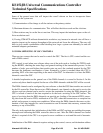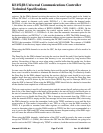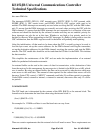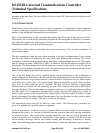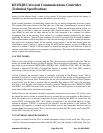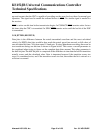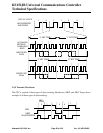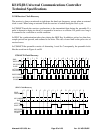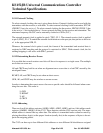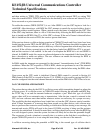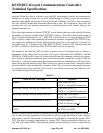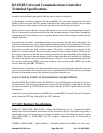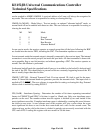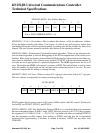
KS152JB Universal Communications Controller
Technical Specifications
Kawasaki LSI USA, Inc. Page 64 of 120 Ver. 0.9 KS152JB2
3.5.11 External Clocking
To select external clocking, the user is given three choices. External clocking can be used with the
transmitter, with the receiver, or with both. To select external clocking for the transmitter, XTCLK
(GMOD.7) has to be set to a 1. To select external clocking for the receiver, XRCLK (PCON.3) has
to be set to a 1. Set ting both bits to 1 forces external clocking for the receiver and transmitter. The
minimum frequency the GSC can be externally clocked at is 0 Hz (D.C.).
The external transmit clock is applied to pin 4 (TXC), P1.3. The external receive clock is applied
to pin 5 (RXC), P1.4. To enable the external clock function on the port pin, that pin has to be set to
a 1 in the appropriate SFR, P1.
Whenever the external clock option is used, the format of the transmitted and received data is
restricted to NRZ encoding and the protocol is restricted to SDLC. With external clock, the bit
stuffing/stripping is still active with SDLC protocol.
3.5.12 Determining Receiver Errors
It is possible that several receiver error bits will be set in response to a single cause. The multiple
errors that can occur are:
AE and CRCE may both be set when an alignment error occurs due to a bad CRC caused by the
misaligned frame.
RCABT, AE, and CRCE may be set when an abort occurs.
OVR, AE, and CRCE may be set when a overrun occurs.
In order to determine the correct cause o the error a specific order should be followed when exam-
ining the error bits. This order is:
1) OVR
2) RCBAT
3) AE
4) CRCE
3.5.13 Addressing
There are four 8-bit address registers (ADR0, ADR1, ADR2, ADR3) and two 8-bit address mask
registers (AMSK0, AMSK1) in the C152. These function with the GSC receiver only. The trans-
mitted address is treated like any other data. The address is transmitted under software control by
placing the address byte(s) at the proper location (usually first) in the sequence of bytes to be out-
put in the outgoing packet.
The C152 can have up to four different 8-bit addresses or two different 16-bit addresses assigned



